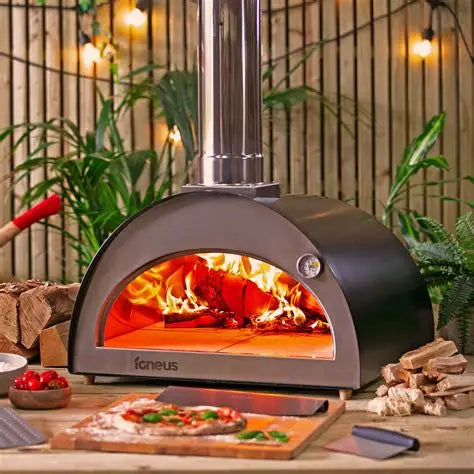
The Right Way to Season Your Pizza Oven: Your Complete Guide to Perfect Pizza Every Time
Share
The Right Way to Season Your Pizza Oven: Your Complete Guide to Perfect Pizza Every Time
So you've finally invested in that beautiful pizza oven you've been dreaming about – congratulations! Whether it's a traditional wood-fired brick oven or a modern outdoor pizza oven, you're about to embark on a culinary journey that will transform your garden entertaining forever. But before you start tossing dough and melting mozzarella, there's one crucial step that many new pizza oven owners overlook: proper seasoning.
Seasoning your pizza oven isn't just a nice-to-have process – it's absolutely essential for achieving those restaurant-quality results you're after. Done correctly, seasoning will protect your oven, improve its performance, and ensure your pizzas come out perfectly crispy with that distinctive smoky flavour. Get it wrong, and you might find yourself dealing with cracked surfaces, uneven heating, or pizzas that taste more like concrete dust than delicious Italian cuisine.
Don't worry though – seasoning your pizza oven is actually quite straightforward once you know what you're doing. Let's walk through everything you need to know to get your oven ready for years of incredible pizza making.

Why Seasoning Your Pizza Oven Matters
Before diving into the how-to, it's worth understanding why seasoning is so important. Think of it as giving your oven the foundation it needs to perform at its best, much like seasoning a cast iron pan creates that perfect non-stick surface we all love.
During the seasoning process, you're essentially curing the materials your oven is made from. This removes any residual moisture that could cause cracking when exposed to high temperatures, whilst also creating a protective barrier that helps regulate heat distribution. For brick and clay ovens, seasoning allows the materials to expand and contract gradually, preventing the thermal shock that can lead to expensive repairs.
The seasoning process also burns off any manufacturing residues, dust, or unwanted materials that might affect the taste of your food. Nobody wants their first homemade pizza to taste like construction materials!
Understanding Your Oven Type
Brick and Clay Ovens
Traditional brick and clay ovens require the most careful seasoning process. These materials are porous and contain natural moisture that needs to be driven out gradually. Rushing this process with brick or clay ovens can result in cracking or structural damage that's both expensive and heartbreaking to repair.
The good news is that once properly seasoned, brick and clay ovens retain heat beautifully and develop wonderful flavours over time. They're definitely worth the extra patience required during the initial seasoning process.
Metal and Stainless Steel Ovens
Modern metal pizza ovens typically require less intensive seasoning, but the process is still important for optimal performance. These ovens heat up faster and cool down quicker than their traditional counterparts, making them more forgiving during the seasoning process.
Buy Wood Fired, Dual Fuel and Gas Pizza Ovens at Sal's Place
The Complete Seasoning Process
Initial Inspection and Cleaning
Before lighting your first fire, give your oven a thorough inspection. Check for any obvious damage, loose materials, or debris that might have accumulated during installation. A soft brush and slightly damp cloth can remove dust and particles, but avoid using any chemical cleaners that might leave residues.
Pay particular attention to the oven floor where your pizzas will sit. This surface needs to be completely clean and free from any installation materials or protective coatings that might have been applied during manufacturing.
The First Fire: Low and Slow
Your first seasoning fire should be small, gentle, and relatively short. We're talking about a fire that barely reaches 100°C – much lower than you'll ever use for actual cooking. This initial fire begins the moisture removal process without shocking the materials.

Start with very dry kindling and small pieces of hardwood. Avoid softwoods like pine or fir, as these can leave resinous deposits that affect flavour. Oak, ash, or fruit woods work brilliantly for seasoning fires. Keep this first fire burning for about 2-3 hours, gradually adding small amounts of fuel to maintain a steady, low temperature.
Don't worry if you see steam coming from the oven during this first fire – that's exactly what should happen as residual moisture evaporates. However, if you notice any cracking or unusual sounds, reduce the temperature immediately and allow the oven to cool slowly.
Building Heat Gradually
Over the next several firing sessions, gradually increase the temperature and duration. Your second fire might reach 150°C for 3-4 hours, your third could hit 200°C for a similar duration, and so on. This gradual approach allows the materials to adapt slowly to increasing temperatures.
Most experts recommend at least five separate seasoning fires before attempting to cook anything in your oven. Yes, it requires patience, but this investment of time will pay dividends in the long run with better performance and longer oven life.
Recognising Proper Seasoning
You'll know your oven is properly seasoned when the interior surfaces have developed a light, even colouring and the materials no longer release visible moisture during heating. The oven should heat up smoothly without any unusual sounds, and the temperature should distribute evenly across the cooking surface.
Common Seasoning Mistakes to Avoid
Rushing the Process
The biggest mistake new pizza oven owners make is impatience. It's understandable – you're excited to start cooking! However, rushing the seasoning process by using too high temperatures too quickly can cause permanent damage that's expensive to repair.
Remember, seasoning is an investment in your oven's future performance. Taking the time to do it properly now will save you headaches and expenses later.
Using the Wrong Fuel
Not all wood is suitable for seasoning fires. Avoid treated lumber, painted wood, or anything that might contain chemicals or adhesives. Stick to clean, dry hardwoods that burn cleanly without producing harmful residues.

Charcoal can be used for seasoning, but wood gives better results and helps develop the flavours that make wood-fired cooking so special. If you do use charcoal, make sure it's natural lump charcoal rather than briquettes, which often contain binding agents.
Ignoring Weather Conditions
Trying to season your oven during damp or humid weather can extend the process significantly. The materials will absorb moisture from the air, making it harder to achieve proper curing. Choose dry, preferably breezy days for your seasoning fires when possible.
If you live in a consistently humid climate, you might need additional seasoning sessions to achieve optimal results. Don't be discouraged – just take your time and let the process happen naturally.
Maintaining Your Seasoned Oven
Regular Use is Key
The best way to maintain your oven's seasoning is to use it regularly. Each time you fire up the oven, you're reinforcing the seasoning and improving its performance. Even if you're not cooking, occasional heating helps prevent moisture absorption and maintains the protective barriers you've created.
Aim to use your oven at least once a month, even during winter months when outdoor cooking might be less appealing. A quick heating session is better than letting the oven sit unused for extended periods.
Cleaning and Care
After each use, allow your oven to cool completely before cleaning. A stiff brush can remove food residues and ash, but avoid using water or cleaning chemicals that might damage the seasoning. For stubborn residues, heat the oven again and scrape away debris when it's warm but not hot.
Buy accessories for pizza ovens at Sal's Place
Store pizza peels, brushes, and other tools in a dry location to prevent them from introducing moisture into your oven during use.
Troubleshooting Common Issues
Uneven Heating
If your oven develops hot spots or uneven heating after seasoning, it might indicate incomplete moisture removal or structural issues. Additional seasoning fires focusing on gradually increasing temperatures often resolve these problems.
Surface Discolouration
Don't panic if your oven's interior changes colour during seasoning – this is completely normal. The surfaces should develop an even, light brown or grey colouring that indicates proper curing. Dramatic colour changes or black sooty deposits might indicate you're burning the fires too hot too quickly.
Continuing Moisture Issues
If your oven continues releasing visible moisture after several seasoning sessions, you may need to extend the process with additional low-temperature fires. This is particularly common with thick brick or stone ovens in humid climates.
When to Re-Season
Even properly seasoned ovens may need re-seasoning over time, particularly if they've been unused for extended periods or exposed to extreme weather conditions. Signs that re-seasoning might be needed include:
- Unusual amounts of moisture during heating
- Uneven temperature distribution
- Changes in food flavour that suggest material contamination
- Visible damage to interior surfaces
Re-seasoning typically requires fewer sessions than initial seasoning, as the materials have already been conditioned to some extent.
Your First Pizza: The Moment of Truth
Once your oven is properly seasoned, you're ready for that magical first pizza! Start with simple margherita pizzas to test your oven's performance and get a feel for cooking times and temperatures. The seasoning process should have created an oven that heats evenly, retains temperature well, and imparts subtle smoky flavours to your food.
Buy accessories for pizza ovens at Sal's Place
Don't expect perfection immediately – like any cooking technique, mastering pizza oven cooking takes practice. But with a properly seasoned oven as your foundation, you'll be amazed at the results you can achieve.
Beyond Pizza: Exploring Your Seasoned Oven's Potential
While you're seasoning your oven specifically for pizza, don't forget that a well-seasoned oven opens up a world of cooking possibilities. Bread baking, roasted vegetables, slow-cooked meats, and even desserts all benefit from the unique heat characteristics of a properly prepared oven.
As your confidence grows, experiment with different cooking techniques and temperature ranges. Your seasoned oven will reward your patience with years of incredible meals and memorable gatherings.
Getting Started with Confidence
Seasoning your pizza oven properly is one of the most important steps in your outdoor cooking journey. While it requires patience and careful attention to detail, the process isn't complicated when you understand the principles involved. Take your time, follow the guidelines, and don't rush the process.
Remember, every pizza oven is slightly different, and factors like climate, materials, and size can affect the seasoning requirements. Trust your observations and don't hesitate to extend the process if your oven seems to need additional time.
Ready to start seasoning your pizza oven the right way? Sal's Place stocks everything you need for proper oven seasoning and maintenance, from the right types of wood to professional-grade thermometers and cleaning tools. Our team understands the importance of proper seasoning and can provide guidance specific to your oven type and local conditions.
Buy Wood Fired, Dual Fuel and Gas Pizza Ovens at Sal's Place
Have you recently seasoned a pizza oven? We'd love to hear about your experience and any tips you discovered along the way. Proper seasoning is the foundation of great pizza making, and sharing knowledge helps everyone achieve better results. What questions do you have about the seasoning process, and what would you like to cook first in your perfectly prepared oven?











